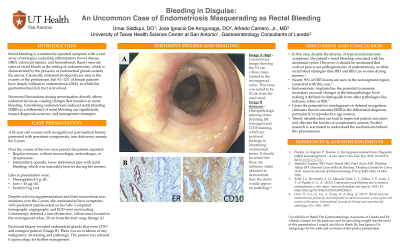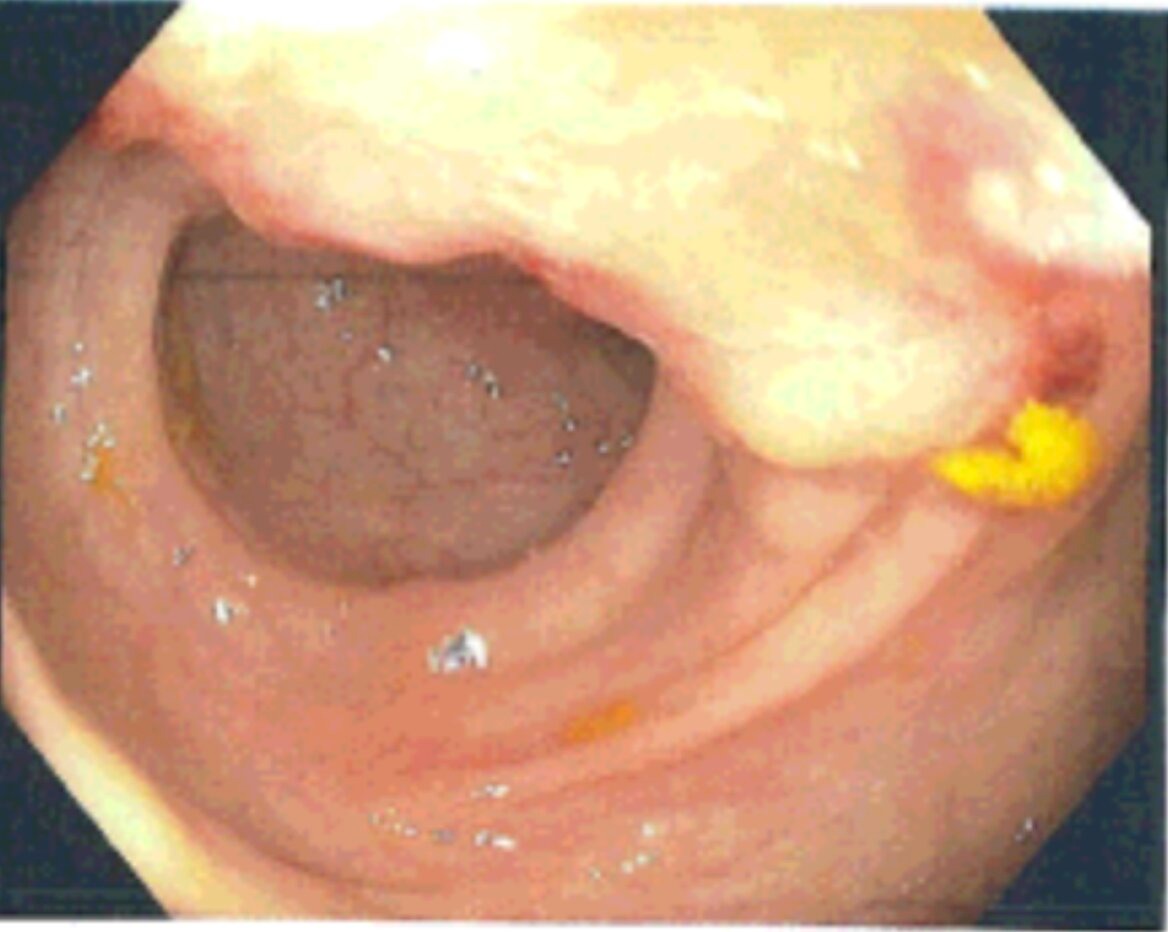Monday Poster Session
Category: GI Bleeding
P2070 - Bleeding in Disguise: An Uncommon Case of Endometriosis Masquerading as Rectal Bleeding
Monday, October 23, 2023
10:30 AM - 4:15 PM PT
Location: Exhibit Hall

Has Audio

Umar Siddiqui, DO
University of Texas Health Science Center-San Antonio
Presenting Author(s)
Umar Siddiqui, DO1, Jose I.. De Arrigunaga, DO2, Alfredo Camero, MD3
1University of Texas Health Science Center-San Antonio, San Antonio, TX; 2University of Texas Health Science Center at San Antonio, San Antonio, TX; 3Gastroenterology Consultants of Laredo, Laredo, TX
Introduction: Rectal bleeding is a commonly reported symptom with various etiologies, including inflammatory bowel disease, colorectal tumors, and hemorrhoids. Rarely seen are cases of rectal bleeds in the setting of endometriosis, a benign condition characterized by the presence of endometrial glands outside the uterus. Classically, endometrial deposits are seen in the ovaries or the peritoneum, but 5%-12% of female patients have deeply infiltrative endometriosis (DIE), in which the gastrointestinal (GI) tract is involved. Hormonal fluctuations during menstruation directly affect this endometrial tissue, causing changes that manifest as rectal bleeding. Herein we present a case of a female patient who presented with endometriosis-induced rectal bleeding (EIRB). Considering EIRB as a differential of rectal bleeding can significantly impact diagnostic accuracy and management strategies.
Case Description/Methods: A 42-year-old woman with no significant past medical history presented with persistent symptomatic iron deficiency anemia for 2 years. The patient reported regular menses, without menorrhagia, metrorrhagia, or dyspareunia. She did report episodic lower abdominal pain with rectal bleeding. The bleeding was reported as intermittent but noticeably heavier during her menses. Labs at presentation included hemoglobin 8.5 g/dL, iron < 10 μg/dL, and ferritin 9. Despite oral iron supplementation and three intravenous iron infusions over the 2 years, she continued to have symptoms. Computed tomography angiography did not reveal any abnormalities. Colonoscopy detected a non-obstructive, villous mass located in the rectosigmoid colon, 20 cm from the anal canal (Image A). Excisional biopsy revealed endometrial glands that were CD10 and estrogen positive. The patient was referred to gynecology for further management.
Discussion: This case highlights the importance of recognizing EIRB as a rare cause of rectal bleeding. Despite the absence of typical endometriosis symptoms, the patient's rectal bleeding coincided with her menstrual cycles. Moreover, nearly 90% of DIE lesions are seen in the rectosigmoid region, consistent with this case. Given the potential for misdiagnosis or delayed recognition, clinicians should consider EIRB in the differential diagnosis, particularly in women of reproductive age. Timely identification can lead to improved patient outcomes and alleviate the burden of symptomatic anemia. Further research is warranted to understand the mechanisms behind this phenomenon.

Disclosures:
Umar Siddiqui, DO1, Jose I.. De Arrigunaga, DO2, Alfredo Camero, MD3. P2070 - Bleeding in Disguise: An Uncommon Case of Endometriosis Masquerading as Rectal Bleeding, ACG 2023 Annual Scientific Meeting Abstracts. Vancouver, BC, Canada: American College of Gastroenterology.
1University of Texas Health Science Center-San Antonio, San Antonio, TX; 2University of Texas Health Science Center at San Antonio, San Antonio, TX; 3Gastroenterology Consultants of Laredo, Laredo, TX
Introduction: Rectal bleeding is a commonly reported symptom with various etiologies, including inflammatory bowel disease, colorectal tumors, and hemorrhoids. Rarely seen are cases of rectal bleeds in the setting of endometriosis, a benign condition characterized by the presence of endometrial glands outside the uterus. Classically, endometrial deposits are seen in the ovaries or the peritoneum, but 5%-12% of female patients have deeply infiltrative endometriosis (DIE), in which the gastrointestinal (GI) tract is involved. Hormonal fluctuations during menstruation directly affect this endometrial tissue, causing changes that manifest as rectal bleeding. Herein we present a case of a female patient who presented with endometriosis-induced rectal bleeding (EIRB). Considering EIRB as a differential of rectal bleeding can significantly impact diagnostic accuracy and management strategies.
Case Description/Methods: A 42-year-old woman with no significant past medical history presented with persistent symptomatic iron deficiency anemia for 2 years. The patient reported regular menses, without menorrhagia, metrorrhagia, or dyspareunia. She did report episodic lower abdominal pain with rectal bleeding. The bleeding was reported as intermittent but noticeably heavier during her menses. Labs at presentation included hemoglobin 8.5 g/dL, iron < 10 μg/dL, and ferritin 9. Despite oral iron supplementation and three intravenous iron infusions over the 2 years, she continued to have symptoms. Computed tomography angiography did not reveal any abnormalities. Colonoscopy detected a non-obstructive, villous mass located in the rectosigmoid colon, 20 cm from the anal canal (Image A). Excisional biopsy revealed endometrial glands that were CD10 and estrogen positive. The patient was referred to gynecology for further management.
Discussion: This case highlights the importance of recognizing EIRB as a rare cause of rectal bleeding. Despite the absence of typical endometriosis symptoms, the patient's rectal bleeding coincided with her menstrual cycles. Moreover, nearly 90% of DIE lesions are seen in the rectosigmoid region, consistent with this case. Given the potential for misdiagnosis or delayed recognition, clinicians should consider EIRB in the differential diagnosis, particularly in women of reproductive age. Timely identification can lead to improved patient outcomes and alleviate the burden of symptomatic anemia. Further research is warranted to understand the mechanisms behind this phenomenon.

Figure: Image A: Colonoscopy image showing the 5.2 cm villous mass located in the rectosigmoid colon. This mass was noted to be 20 cm from the anal canal.
Disclosures:
Umar Siddiqui indicated no relevant financial relationships.
Jose De Arrigunaga indicated no relevant financial relationships.
Alfredo Camero indicated no relevant financial relationships.
Umar Siddiqui, DO1, Jose I.. De Arrigunaga, DO2, Alfredo Camero, MD3. P2070 - Bleeding in Disguise: An Uncommon Case of Endometriosis Masquerading as Rectal Bleeding, ACG 2023 Annual Scientific Meeting Abstracts. Vancouver, BC, Canada: American College of Gastroenterology.
